by Martin Green
One of the most fun aspects of being a watch journalist is occasionally getting to see fantastic projects in development and watching as they come to life step by step.
Sometimes it is a (new) brand with a sketch or prototype of things to come, watches you might only hold in your hand a year or so later. And sometimes collectors have exciting things going on as well.
About a year and a half ago, a collector got in touch regarding an engraving project on a Jaeger-LeCoultre Reverso. This might very well be the most commonly engraved watch as the reversible case makes for the perfect canvas for custom artwork or a personal message.
What caught my attention in this project was that the collector was collaborating with an engraver very close to my home, which would allow me to follow the project’s progression with my own eyes. And what got me completely hooked on the project was that this collector didn’t even own a Reverso at the time.
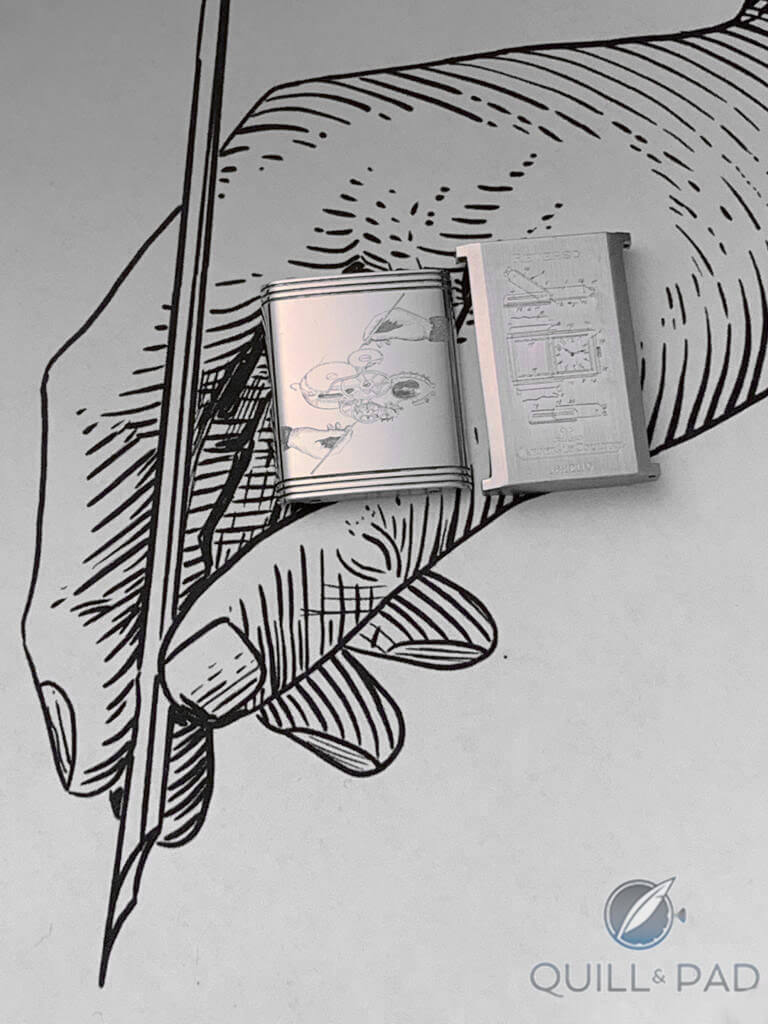
Custom engraved Jaeger-LeCoultre Reverso Classique (photo courtesy Cécile Oorthuis)
Finding the right canvas for the artwork
There was a method to this madness. For him, it wasn’t about engraving a Reverso with something he liked; he considered the watch to be part of the concept. He thought of the Reverso as the canvas and frame as one entity that would significantly influence the engraving.
The engraving itself was also something he had a strong opinion about. He was not interested in engraving his initials or an image of something dear to him, as he realized that it is very likely that the Reverso would still be alive and “ticking” even when he wasn’t. Therefore, he wanted the engraving to have a meaning transcending himself, which could be appreciated by a wider audience as a form of art.
At the same time, he also wanted the engraving to have a strong link with the watch itself, making for quite a challenge.
Finding the right Reverso was the first step in the project. It couldn’t be a Reverso with a sapphire crystal case back (nothing to engrave) or a Duoface, which has a dial on both sides.
While this narrowed things down somewhat, there are still quite a few Reversos to consider as Jaeger-LeCoultre has offered myriad variations on this watch over the 89 years since its introduction.
While gold is an obvious choice for elaborately engraving a watch, the collector didn’t discard the idea of stainless steel. While engraving stainless steel comes with challenges of its own, steel offers a different, slightly sharper looking result than engraving in a softer precious metal.
Models such as the exquisite Reverso Tribute and Reverso Classique Or Deco were considered, but didn’t make the cut. This had nothing to do with their qualities: to the contrary, these watches are so expressive that they are attractions themselves. This might make them the perfect canvas for some, but this collector wanted to go back to basic, meaning that the watch had to be as low key as possible.
He eventually purchased a stainless steel Reverso Classique from the late 1990s in mint condition for this project. While the larger Reverso Grande Taille was also considered, the collector discarded it for a very curious reason: not only would a smaller watch be even more understated, it would also compress the engraving, making it more challenging to accomplish.
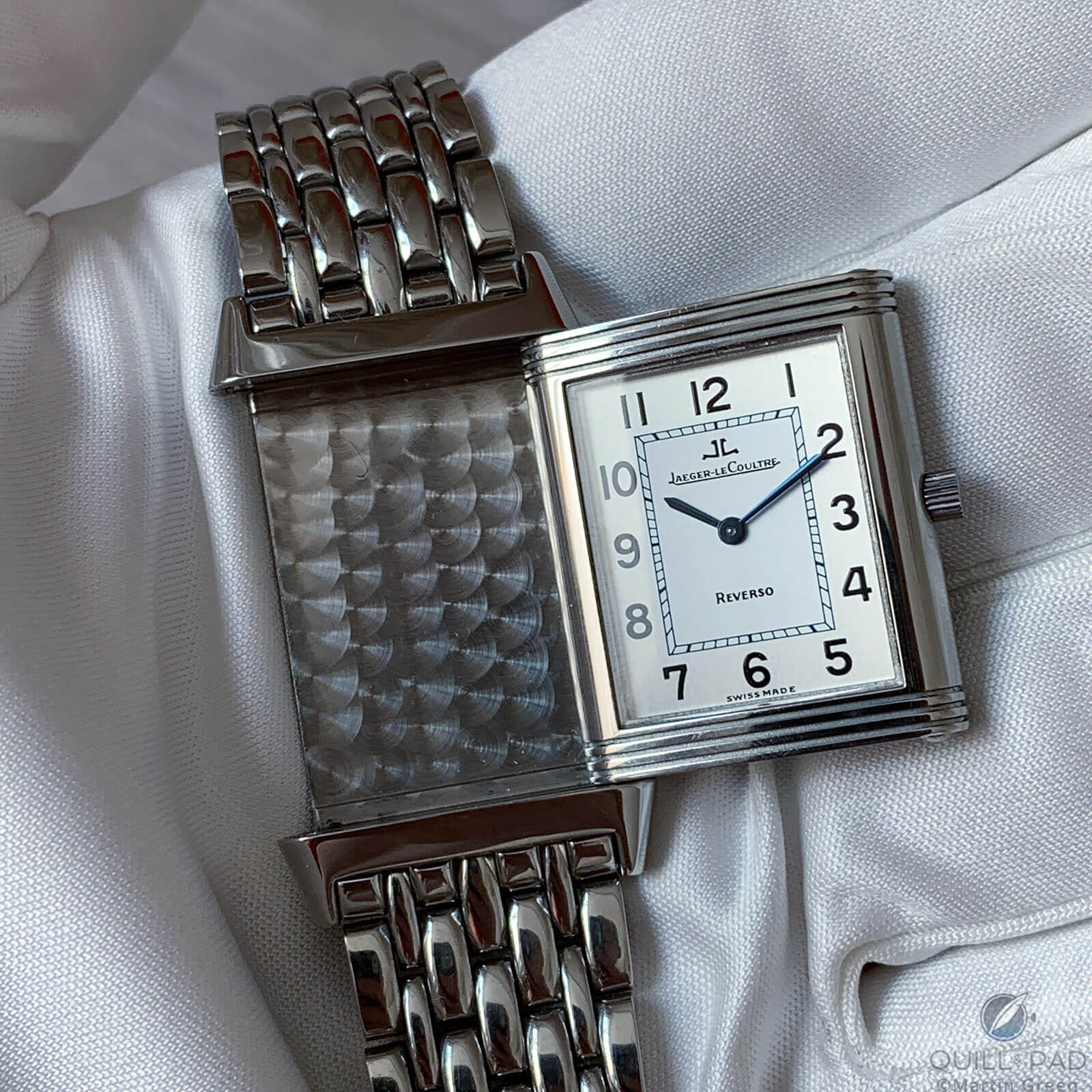
The collector’s newly acquired Jaeger-LeCoultre Reverso Classique
It is also interesting to note that the collector chose a Reverso Classique with a matching stainless steel bracelet. Those familiar with this seven-link bracelet will know that it is remarkably supple and completely changes the look of the watch.
While an ostrich or alligator skin strap gives the Reverso a very classic look, the bracelet adds a certain extra air of masculinity. This is perhaps strange to say as the Reverso Classique only measures 32.9 x 23.1 mm, but we see the same effect with other relatively smaller watches on a bracelet like the Tank Louis Cartier.
As the case and bracelet are the same material, and both are polished, the emphasis is on the dial, which boasts a remarkable flair emanating from just a few elements: a minimum of writing and two blued sword-shaped hands.
These hands match the dark blue railroad track that separates the matte finish inside of it from the satin finish outside of it, which is home to the 12 Arabic numerals pad-printed in black. Perhaps to some extent this also explains the staying power of the Reverso: it may be elementary in design, but it is executed so well that you get a sense of timeless beauty. This is a level that so many watches aspire to, yet so few reach.
The engraver: the vital key to a beautifully engraved watch
A personalized, engraved watch can only be as good as its engraver, so you don’t just ask anybody to do it. Finding an engraver is already quite a challenge these days – though Jaeger-LeCoultre does offer it in the manufactory – but finding an independent artisan who can execute a project at this level is nearly impossible.
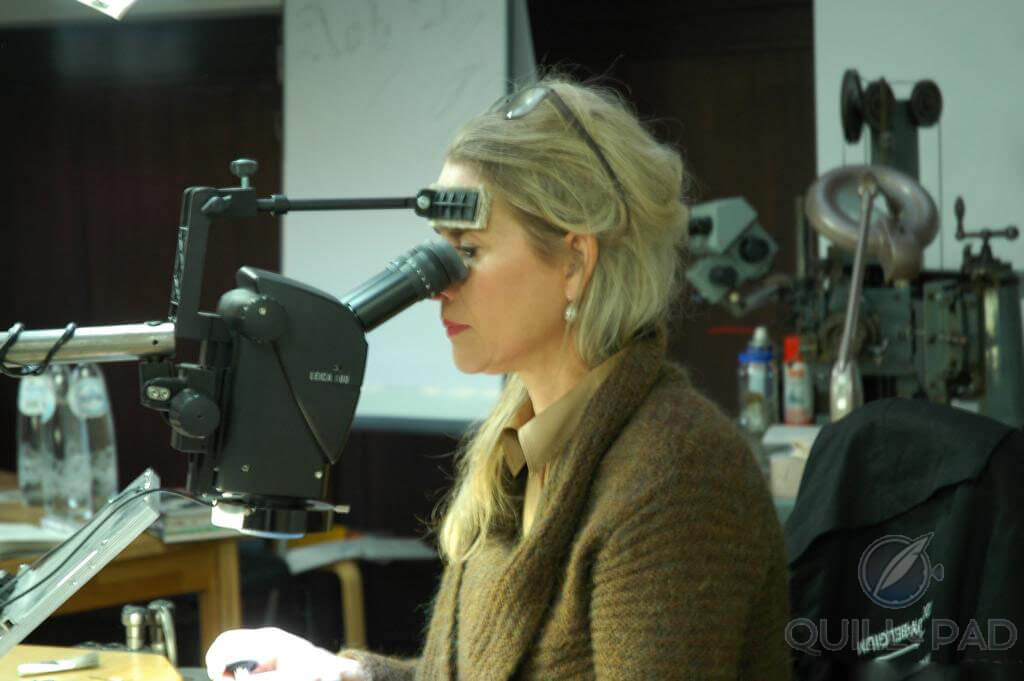
Engraver Cécile Oorthuis at work
The rarity of these artisans exists partly because there are hardly any schools or programs teaching engraving anymore. This is also what Cécile Oorthuis, the engraver entrusted with this project, experienced.
Both of her parents were goldsmiths, and while she was tempted to follow in their footsteps, the call of music was stronger. She trained at a conservatory, where she mastered the Western concert flute and became a professional musician.
In 2010 an acquaintance told her about an evening course in hand-engraving, one of the last available, which she had enrolled in, and so did Oorthuis. It was here she learned to engrave entirely by hand without the aid of laser- or computer-controlled technology.
Afterward, Oorthuis went on to find other ways to hone her skills. Aside from endless practice, she studied the work of American master engravers, including Sam Alfano. This engraver from Louisiana is one of the true masters in his field, and Oorthuis spent a week with him, learning some of his most coveted techniques.
When most people think of engraving, they think of gracious lettering on the back of a watch or inside a wedding ring, but this is merely one of many possibilities. Using shading, Oorthuis learned how to engrave intaglio, but she also spent time exploring the sculpting technique of bas relief where material is carved away to create a relief sculpture.
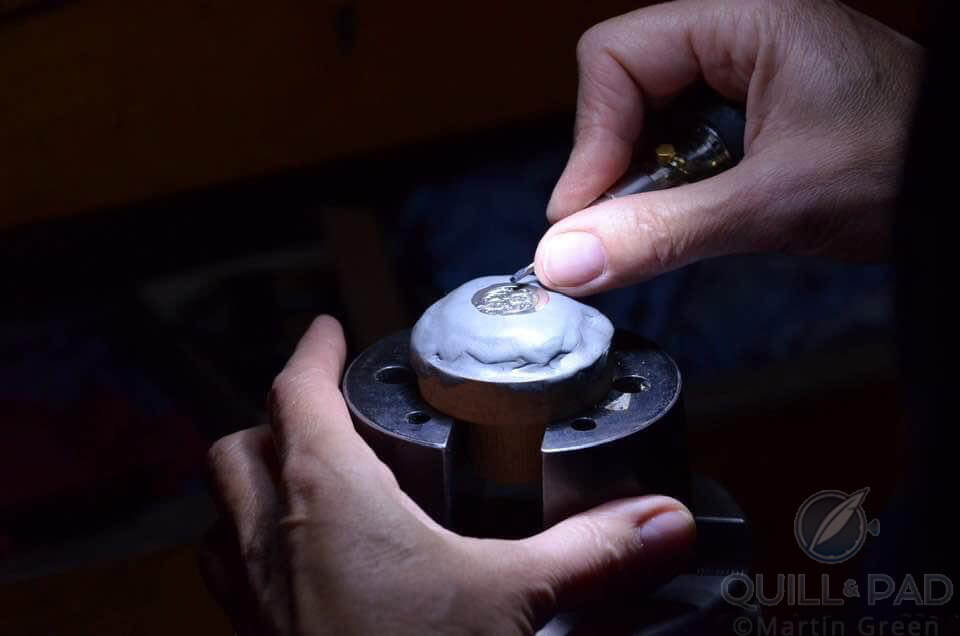
Engraver Cécile Oorthuis at work
Many of these techniques require incredible acumen in the fingers – as well as quite a bit of strength – as the artisan must carve out metal. When you do this as often as Oorthuis, your shoulder becomes especially susceptible to injury. One of the things that helps her prevent this is an Airgraver, a hand-held tool that uses pneumatic power to cut out the metal. The heavy lifting is done by the machine, so Oorthuis can focus on creating the design, which allows her to work longer and in a healthier manner.
Her extraordinary skills have allowed her to work on many unique projects such as movie awards and signet rings of nobility. But engraving watches like this project with the Reverso is definitely part of her resume.
Jaeger-LeCoultre Reverso: patented art deco marvel
When Reversos are engraved, the focus is usually just on the back of the swiveling case. The collector wondered why as the watch’s unique construction allows it to be engraved on two surfaces.
The engraving meant to decorate the metal that sits on the wrist and serves as the frame for the watch case to swivel within was established early on in the project. As this design is in essence also an homage to the watch itself, the collector wanted parts of the original patent drawings to be engraved on the back.
The original patent was filed on March 4, 1931 in Paris by Alfred Chauvot. Chauvot, an engineer, was asked by César de Trey, a distributor of Swiss wristwatches, to develop a solution to protect the fragile mineral crystal of a watch during a polo match.
De Trey was presented with this problem as he traveled through India the year before, where the popularity of this noble game was at an all-time high. A close associate of Jacques-David LeCoultre, de Trey also knew that Jaeger-LeCoultre was the firm to make the Reverso a reality. While few manufactures possess a history as rich as that of Jaeger-LeCoultre, the Reverso managed to become one of its crown jewels.
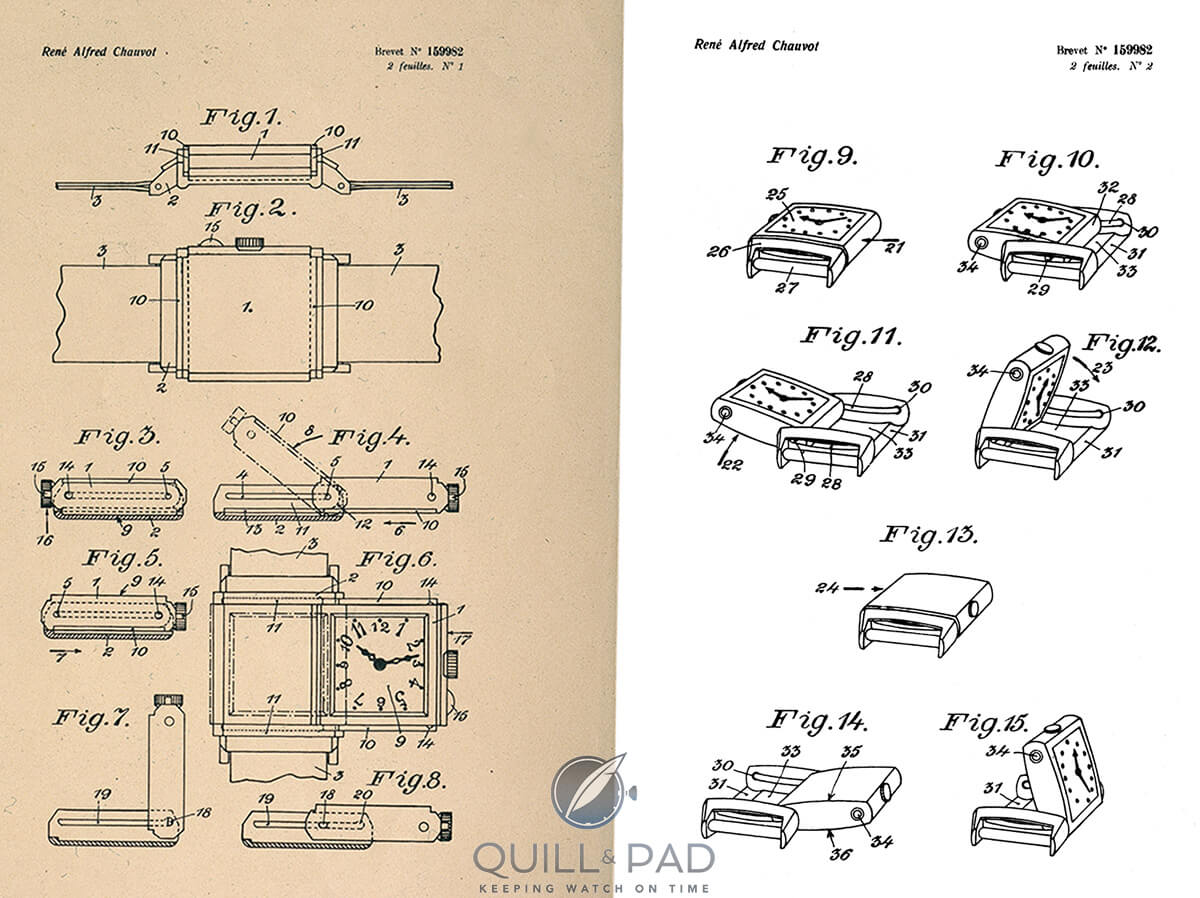
The patent for the Jaeger-LeCoultre Reverso from 1931
For a brief moment, the collector and Oorthuis considered engraving the entire patent sheet on the case back. While this was well within Oorthuis’s abilities, the engravings would have become so small that a loupe would be necessary to enjoy them.
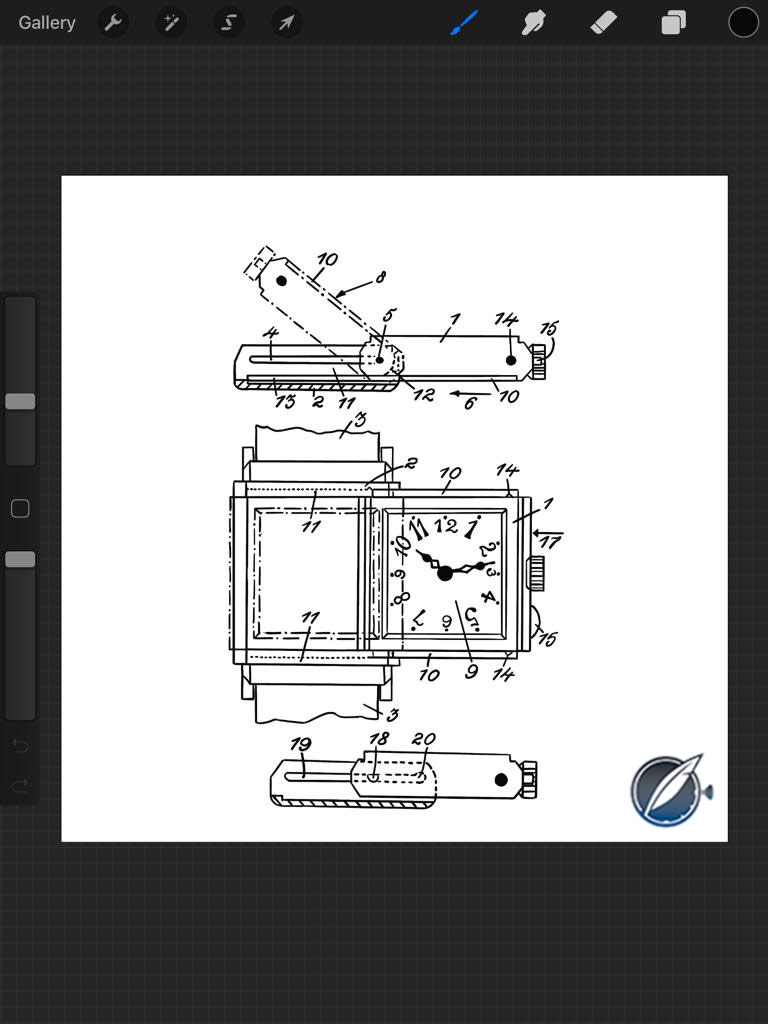
The chosen diagram from the original patent for the Jaeger-LeCoultre Reverso
Instead, she and the collector concluded it would be better to select the three most significant images of the patent sheet and engrave those. Figures four, six, and eight were chosen for this, not only because they are conveniently placed above each other, but also because they also show the essence of what makes the Reverso case so unique. As these technical drawings show quite a bit of detail, Oorthuis had her work cut out for her.
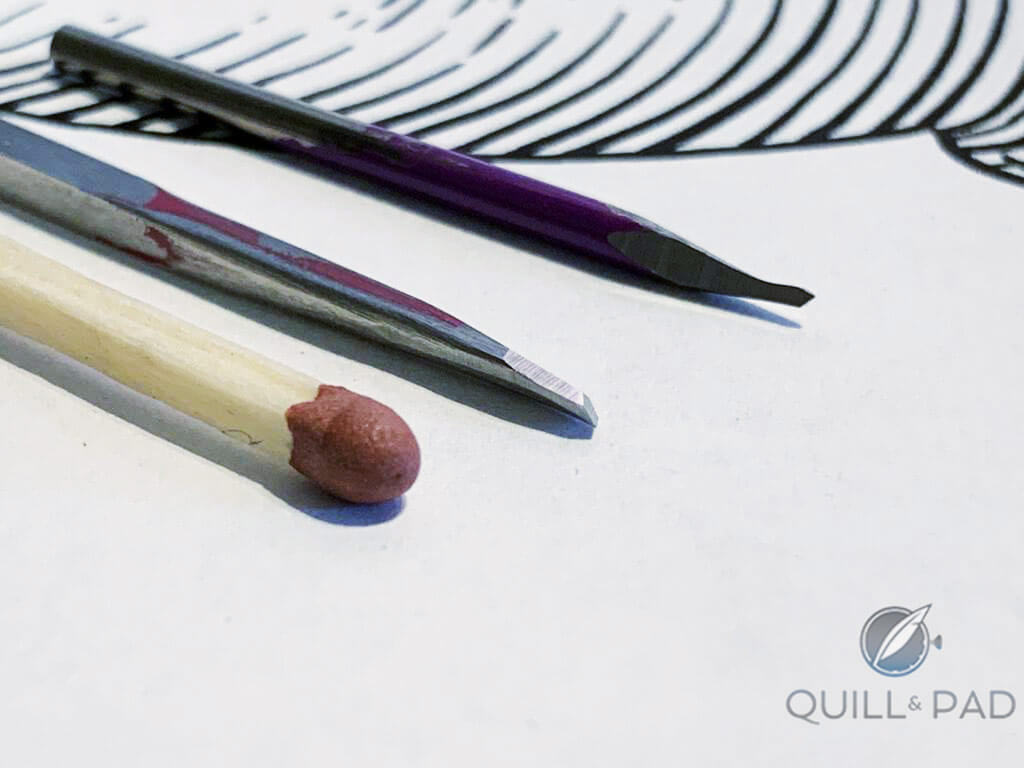
A couple of Cécile Oorthuis’s engraving tools compared with a match head (photo courtesy Cécile Oorthuis)
Oorthuis uses a microscope to enlarge the surface she is working on, allowing her to engrave even the finest detail with great precision. To reach the required fineness, Oorthuis makes her own tools.
The result is perhaps too good as even the numbers indicating the different parts of the case show the same flair as that of the original drawings. Also, the dimensions are spot on – even if a careful observer won’t be fooled, noting that it was all achieved by hand, hours and hours needed for engraving every detail with meticulous precision.
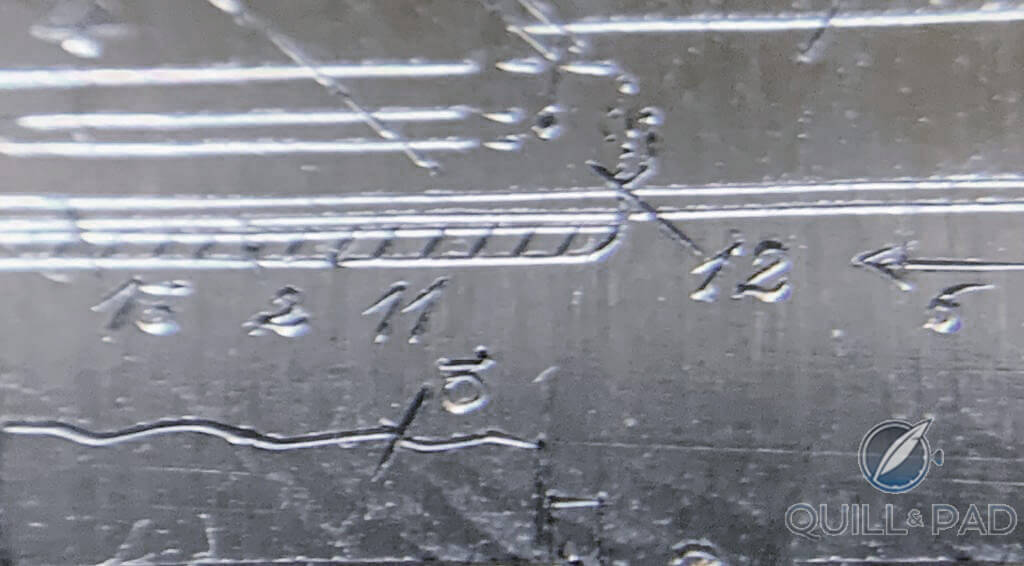
Cécile Oorthuis’s high-precision micro engraving under a microscope (photo courtesy Cécile Oorthuis)
What makes this JLC Reverso tick
This brings us to the second engraving, which took quite a few weeks to bring together. Initially, the idea was to engrave the movement on the actual case back – as if peering into an exhibition back – and frame it with an art deco design.
Engraving a depiction of the movement would look nice and was also pretty straightforward. While Oorthuis was working on the case, the movement was with independent watchmaker Ron Sonders for a complete maintenance service.
While this Reverso Classique was in nearly mint condition, it was also old enough for the movement to warrant some attention to ensure that it would continue to perform as it should. During a discussion about the project with the collector, Sonders suggested engraving all the parts needed for a mechanical movement to work, from mainspring barrel to balance wheel and everything in between. The collector was quite taken with this idea, and together with Oorthuis he selected a three-dimensional drawing displaying the moving parts of a mechanical watch.
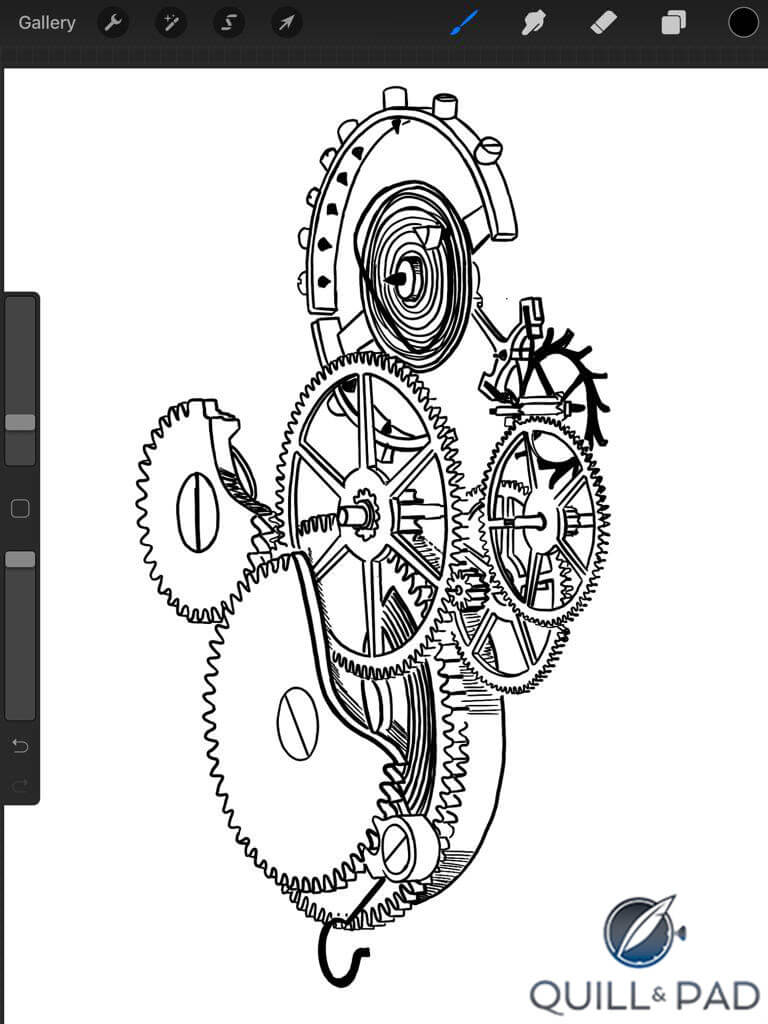
Drawing of the Jaeger-LeCoultre Reverso Classic’s movement gear train
The fact that the image is three-dimensional was only one aspect that made it complicated to engrave. The teeth of each of the gears in the movement had to be engraved as well. They are so fine that even the slightest wrist tremor would destroy the image – and the case back of the Reverso right along with it. Each tooth needed to be placed in perspective, but also have the same size in relation to the others. The balance spring was also particularly challenging to realize as it is very fine and one can quite quickly get off track when engraving around and around . . .
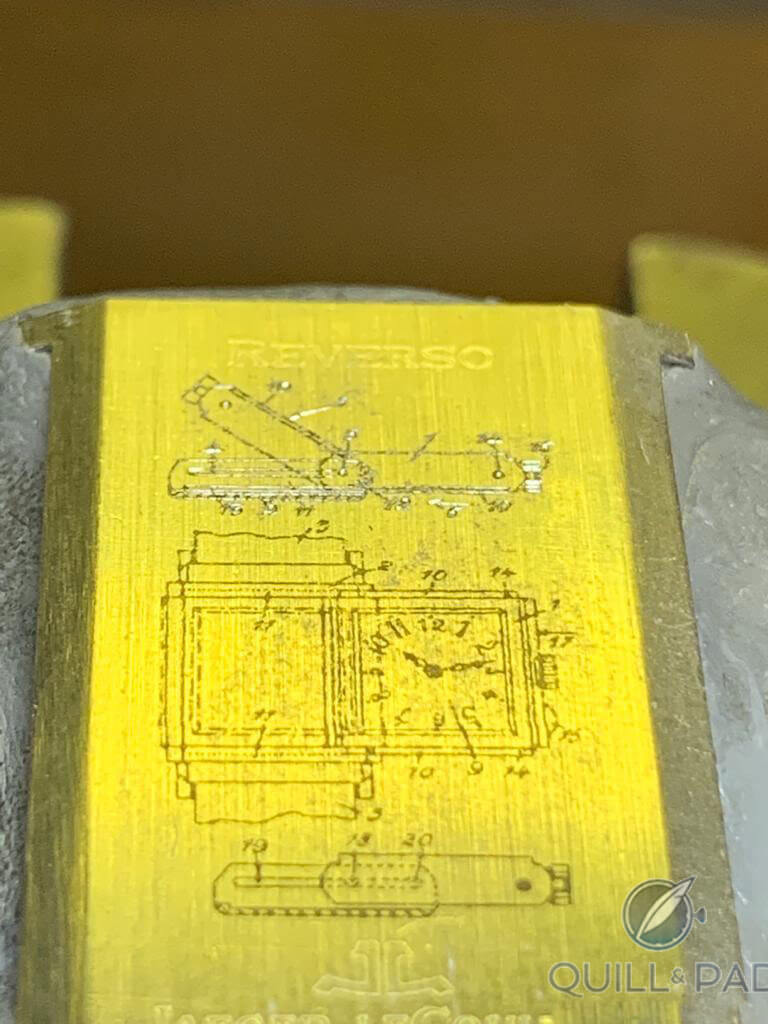
Engraved back of a custom Jaeger-LeCoultre Reverso in progress (photo courtesy Cécile Oorthuis)
Hands of time
While the engraving was superb, there was still quite a bit of empty space on the case back – too much to give it an overall balanced look. The challenge became what to put there as it should complement and not overpower.
The first idea was to add a geometric art deco pattern, but after several designs were virtually tested on a photo on the case back, the collector decided it didn’t work. As a fan of Belgium surrealist artist René Magritte, he got another idea. Adding two hands with pencils gives the impression that the image on the back is being drawn. They change the perception of the three-dimensional technical drawing of mechanical movement components and fill the empty space without overpowering the original image.
To engrave the hands, Oorthuis used a variety of different techniques, one of which was bulino. In Italian, this means “a small handheld graver,” but it is now generally used to refer to a dot technique. Here many small dots create an overall image. This technique comes with challenges of its own, but when mastered it grants engravers like Oorthuis full control over light and dark contrasts.
Thanks to the use of a variety of different techniques, the hands became very realistic looking with a considerable amount of detail.
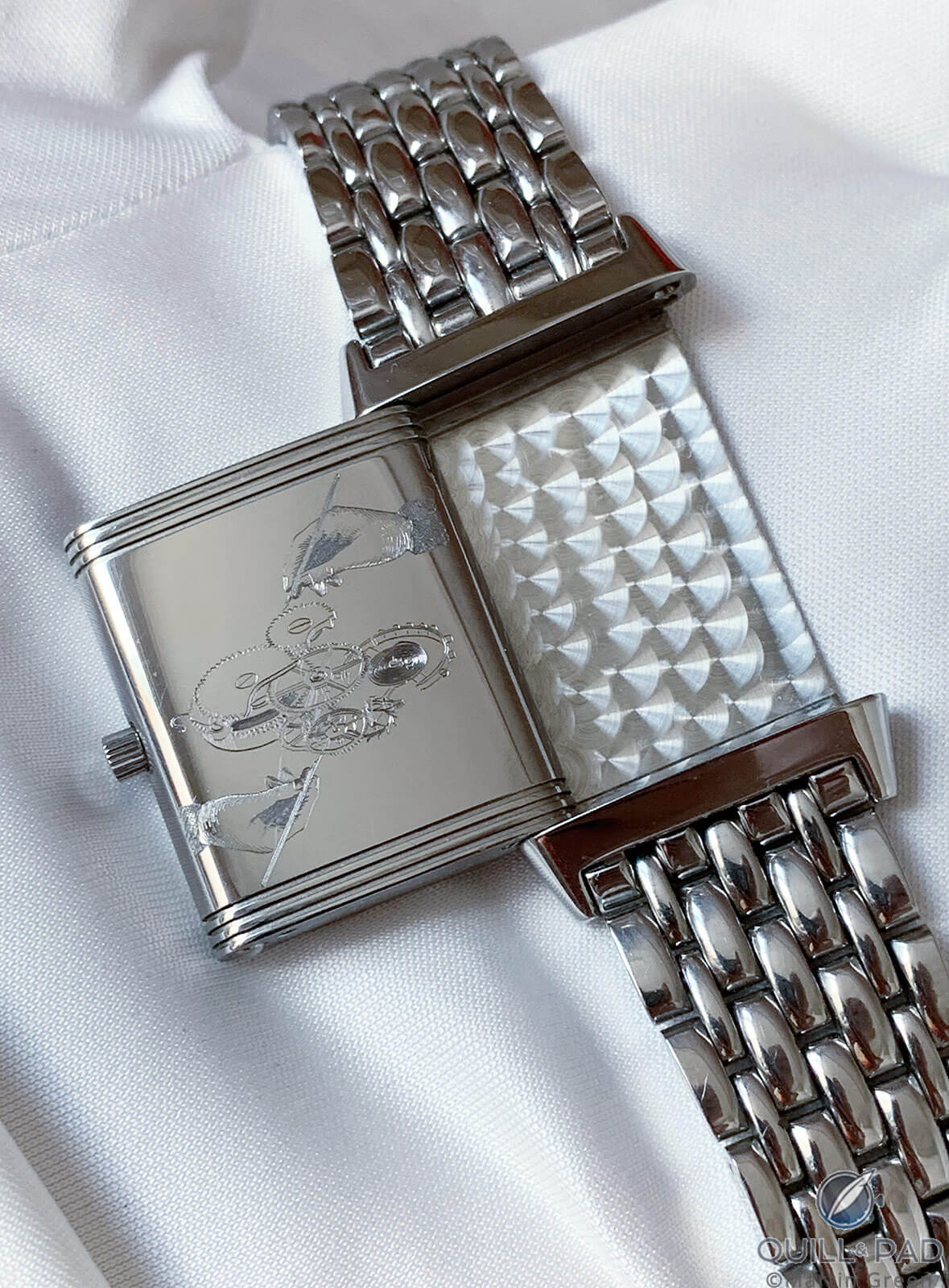
Engraved movement on the case back of a custom Jaeger-LeCoultre Reverso
The ultimate understatement
While the result is absolutely breathtaking, no one is even aware this private joy exists while the collector is wearing his Reverso Classique. With both engravings safely hidden, they become personal pleasures that can be personally shared with fellow enthusiasts if desired.
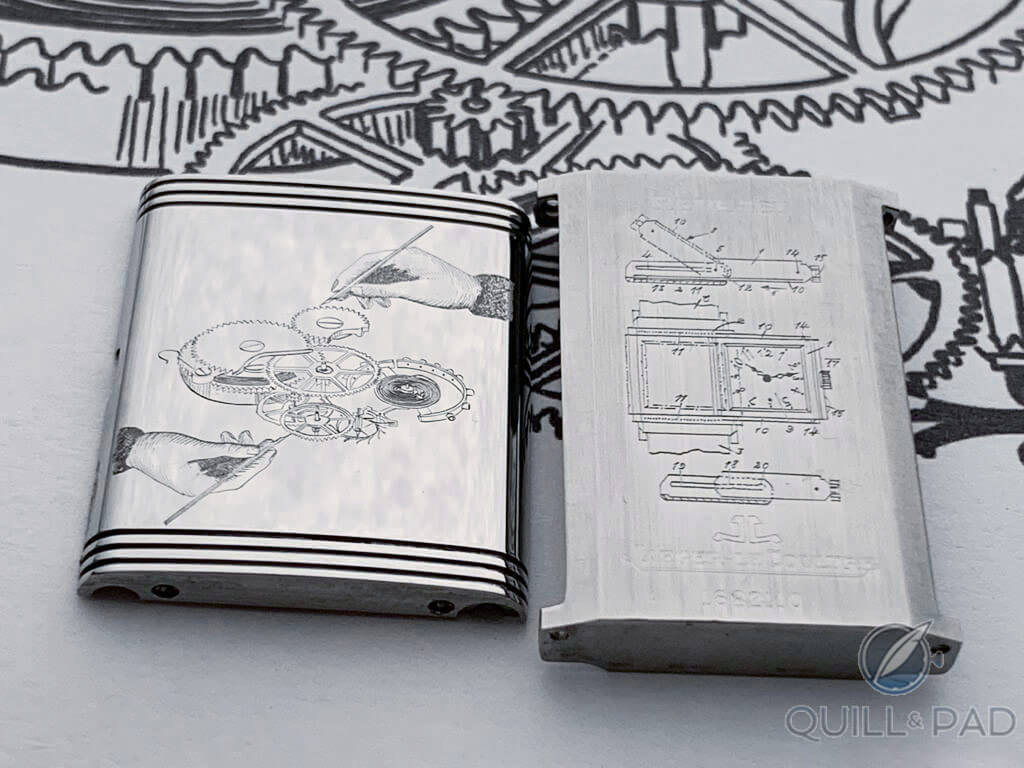
Custom engraved case backs of a Jaeger-LeCoultre Reverso Classique (photo courtesy Cécile Oorthuis)
While the engravings are very personal in the way that they were selected, the images themselves will appeal to a much broader audience. While this collector was looking to create a very special Reverso for his own pleasure, these are the types of engravings that most likely elevate the watch’s value compared to the effect that engraved initials usually have.
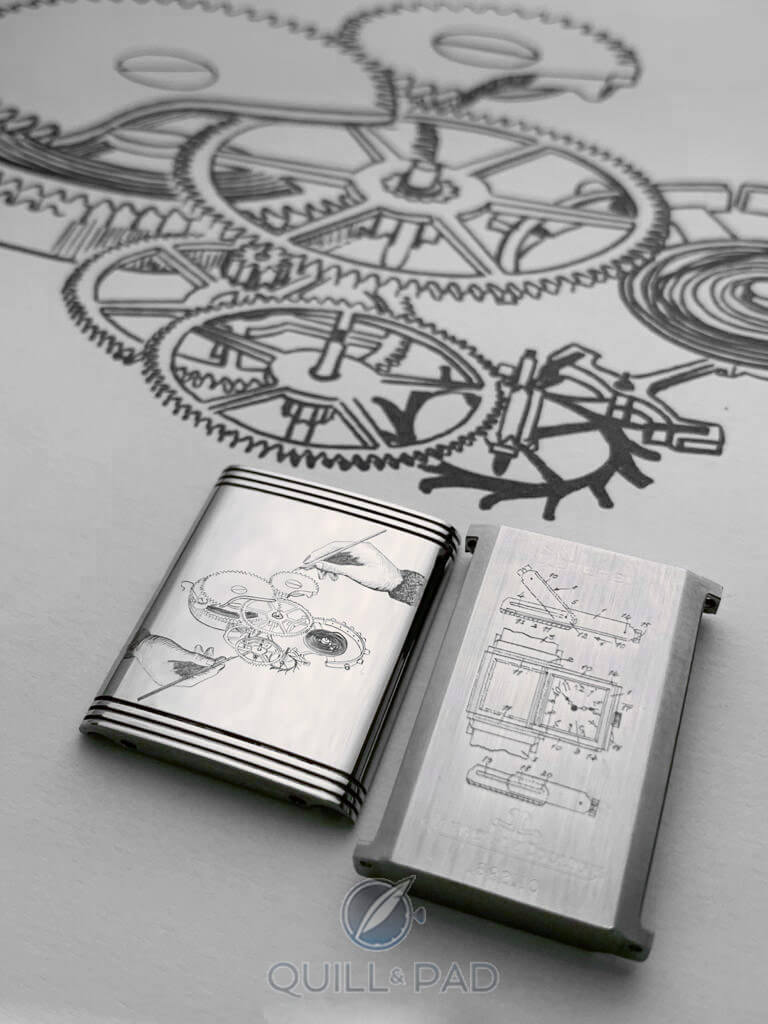
One collector’s custom-engraved Jaeger-LeCoultre Reverso Classique (photo courtesy Cécile Oorthuis)
These engravings highlight in a unique way what makes a mechanical watch in general, and the Reverso in particular, so special. They represent a rare craft, where it is difficult to find masters like Oorthuis who are able to apply their carved art in such a delicate way, turning a collector fantasy into wrist reality.
For more information, please visit www.jaeger-lecoultre.com/eu/en/watches/reverso.
Quick Facts Jaeger-LeCoultre Reverso Classique from 1998
Case: reversible, 32.9 x 23.1 x 8.5 mm, stainless steel
Movement: manual winding Caliber 846/1, 38-hour power reserve
Functions: hours, minutes
Price: 3,980 German marks in 1998 (excluding costs for engraving)
You may also enjoy:
Why I Bought My Wife An Engraved Jaeger-LeCoultre Reverso Classique
Leave a Reply
Want to join the discussion?Feel free to contribute!





















































Glad I decided not to get my current Reverso engraved, as I’m banking on JLC releasing a new Ultra-thin Tribute to 1931 model next year for the 90th anniversary (hopefully it’ll look like the one Gary has), and that’ll be the keeper for getting engraved. Still keen on Schiehallion, but might get something a little more personal.